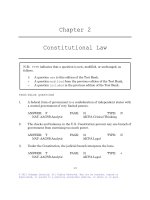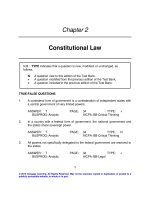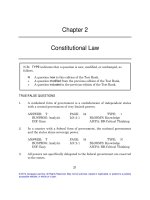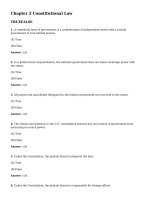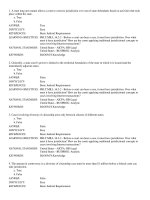Bus law today 9th ed ch08
Bạn đang xem bản rút gọn của tài liệu. Xem và tải ngay bản đầy đủ của tài liệu tại đây (420.16 KB, 34 trang )
BUSINESS LAW TODAY
Essentials 9th Ed.
Roger LeRoy Miller - Institute for University Studies, Arlington, Texas
Gaylord A. Jentz - University of Texas at Austin, Emeritus
Chapter
8
Contracts: Nature,
Classification,
Agreement, and
Consideration
© 2011 Cengage Learning. All Rights Reserved. May not be copied, scanned, or duplicated, in whole or in part, except for use as permitted in
a license distributed with a certain product or service or otherwise on a password-protected website for classroom use.
1
Learning Objectives
What is a contract? What is the objective
theory of contracts?
What are the four basic elements necessary to
a valid contract?
What elements are necessary for an effective
offer? What are some examples of nonoffers?
How do shrink-wrap and click-on agreements
differ from other contracts? How have
traditional laws been applied to these
agreements?
What is consideration? What is required for
consideration to be legally sufficient?
© 2011 Cengage Learning. All Rights Reserved. May not be copied, scanned, or duplicated, in whole or in part, except for use as permitted in
a license distributed with a certain product or service or otherwise on a password-protected website for classroom use.
2
An Overview of Contract Law
Sources of Contract Law.
Common law governs all contracts except when
modified by statutory law such as the UCC.
Function of Contracts:
Fundamental to business.
Creates rights and duties between parties.
Provides stability and predictability.
Parties: Promisor (makes the promise)
and Promisee (accepts the promise).
Good faith in commercial agreements
© 2011 Cengage Learning. All Rights Reserved. May not be copied, scanned, or duplicated, in whole or in part, except for use as permitted in
a license distributed with a certain product or service or otherwise on a password-protected website for classroom use.
3
Definition of a Contract
Agreement that can be enforced in court.
Formed by two or more parties (promisor
and promisee).
Failure to perform results in breach and
damages.
Objective Theory of Contracts.
Intent is interpreted by a reasonable person.
© 2011 Cengage Learning. All Rights Reserved. May not be copied, scanned, or duplicated, in whole or in part, except for use as permitted in
a license distributed with a certain product or service or otherwise on a password-protected website for classroom use.
4
Requirements of a Valid
Contract
A valid, enforceable contract includes:
Agreement.
Consideration.
Capacity.
Legality.
Defenses to the Enforceability of a
Contract:
Genuineness of Assent.
Form.
© 2011 Cengage Learning. All Rights Reserved. May not be copied, scanned, or duplicated, in whole or in part, except for use as permitted in
a license distributed with a certain product or service or otherwise on a password-protected website for classroom use.
5
Classifications Based on
Contract Formation
© 2011 Cengage Learning. All Rights Reserved. May not be copied, scanned, or duplicated, in whole or in part, except for use as permitted in
a license distributed with a certain product or service or otherwise on a password-protected website for classroom use.
6
Bilateral vs. Unilateral
Contracts
Every contract has at least 2 parties: the
Offeror (Promisor) and the Offeree
(Promisee).
Bilateral Contracts:
Offeror and Offeree exchange promises to each
other.
A contract is formed when Offeree promises to
perform.
© 2011 Cengage Learning. All Rights Reserved. May not be copied, scanned, or duplicated, in whole or in part, except for use as permitted in
a license distributed with a certain product or service or otherwise on a password-protected website for classroom use.
7
Bilateral vs. Unilateral
Contracts
Unilateral Contracts:
Offeror wants performance in exchange for his
promise.
Contract is formed when Offeree performs.
Contests and lotteries are examples.
Revocation of Offers for Unilateral
Contracts: modern view is that offer is
irrevocable once the Offeree
substantially performs.
© 2011 Cengage Learning. All Rights Reserved. May not be copied, scanned, or duplicated, in whole or in part, except for use as permitted in
a license distributed with a certain product or service or otherwise on a password-protected website for classroom use.
8
Formal vs. Informal Contracts
Formal: require special form or method
to be enforceable, e.g., under seal.
Informal: all other contracts.
© 2011 Cengage Learning. All Rights Reserved. May not be copied, scanned, or duplicated, in whole or in part, except for use as permitted in
a license distributed with a certain product or service or otherwise on a password-protected website for classroom use.
9
Express vs. Implied Contracts
Express: terms of contract are set forth either
in writing or orally.
Implied-in-Fact: based on conduct.
Plaintiff furnished service or product.
Plaintiff expects to be compensated.
Defendant had a chance to reject and did not.
CASE 8.1
Uhrhahn Construction & Design, Inc.
v. Hopkins (2008). Parties created an enforceable
implied-in-fact contract when both parties waived the
written requirement for changes.
© 2011 Cengage Learning. All Rights Reserved. May not be copied, scanned, or duplicated, in whole or in part, except for use as permitted in
a license distributed with a certain product or service or otherwise on a password-protected website for classroom use.
10
Contract Performance
Contract Performance: Executed vs.
Executory.
Executed: fully performed by both sides.
Executory: at least one of the parties has not
performed.
© 2011 Cengage Learning. All Rights Reserved. May not be copied, scanned, or duplicated, in whole or in part, except for use as permitted in
a license distributed with a certain product or service or otherwise on a password-protected website for classroom use.
11
Contract Enforceability
© 2011 Cengage Learning. All Rights Reserved. May not be copied, scanned, or duplicated, in whole or in part, except for use as permitted in
a license distributed with a certain product or service or otherwise on a password-protected website for classroom use.
12
Contract Enforceability
Valid Contract.
Four Elements: Agreement, Consideration,
Legal Purposes, Parties have legal capacity.
Voidable Contract.
Valid contract that is legally defective and can
be avoided (rescinded) by one of the parties.
Void Contract.
No contract at all.
© 2011 Cengage Learning. All Rights Reserved. May not be copied, scanned, or duplicated, in whole or in part, except for use as permitted in
a license distributed with a certain product or service or otherwise on a password-protected website for classroom use.
13
Quasi Contracts
Fictional, created by court to avoid
unjust enrichment.
Limitations on Quasi-Contractual
Recovery.
When an actual contract already exists,
quasi contract cannot be used.
© 2011 Cengage Learning. All Rights Reserved. May not be copied, scanned, or duplicated, in whole or in part, except for use as permitted in
a license distributed with a certain product or service or otherwise on a password-protected website for classroom use.
14
Agreement: Requirements of
the Offer
An agreement consists of a valid offer
and acceptance.
An offer is the Offeror’s promise to
perform.
An offer requires:
(1) Serious, objective intention.
CASE 8.2 Lucy v. Zehmer (1954). Although
the parties had been drinking, the court found the
circumstanced indicated a serious offer, acceptance
and consideration, and a writing.
© 2011 Cengage Learning. All Rights Reserved. May not be copied, scanned, or duplicated, in whole or in part, except for use as permitted in
a license distributed with a certain product or service or otherwise on a password-protected website for classroom use.
15
Requirements of an Offer
An offer requires (cont’d):
(1) Serious Intention:
• Expressions of Opinions are not offers.
• Statements of Future Intent are not offers.
• Preliminary Negotiations are not offers.
• Advertisements, Catalog, and Circulars are
not offers.
• Auctions are not offers.
• Agreements to Agree are not offers.
© 2011 Cengage Learning. All Rights Reserved. May not be copied, scanned, or duplicated, in whole or in part, except for use as permitted in
a license distributed with a certain product or service or otherwise on a password-protected website for classroom use.
16
Requirements of an Offer
An offer requires (cont’d):
(2) Definiteness: Reasonably definite terms so
that a court can determine whether a breach
has occurred and give an appropriate remedy.
(3) Communication of Offer to Offeree.
© 2011 Cengage Learning. All Rights Reserved. May not be copied, scanned, or duplicated, in whole or in part, except for use as permitted in
a license distributed with a certain product or service or otherwise on a password-protected website for classroom use.
17
Termination of the Offer By
Act of the Parties
Revocation of the Offer (by Offeree) is possible
if communicated to Offeree before the offer is
accepted.
Exception: Irrevocable Offers, based on
detrimental reliance or promissory estoppel, cannot
be revoked.
Option Contracts: requires consideration.
CASE 8.3
T.W. Nickerson, Inc. v. Fleet National
Bank (2009). Optionee, with right of first refusal,
must be notified of “any bona fide offer” to sell the
property for consideration.
© 2011 Cengage Learning. All Rights Reserved. May not be copied, scanned, or duplicated, in whole or in part, except for use as permitted in
a license distributed with a certain product or service or otherwise on a password-protected website for classroom use.
18
Termination of the Offer By
Act of the Parties
Rejection of the Offer by the Offeree.
Effective only when actually received by the
Offeror or its agent.
Counter Offer by the Offeree.
Rejection of original offer and simultaneous
making new offer with different, material
terms. Original Offeror can accept.
“Mirror Image” Rule: at common law, material
terms must be identical or rejection.
© 2011 Cengage Learning. All Rights Reserved. May not be copied, scanned, or duplicated, in whole or in part, except for use as permitted in
a license distributed with a certain product or service or otherwise on a password-protected website for classroom use.
19
Termination of the Offer By
Operation of Law
Lapse of Time.
Offer automatically terminates by law based on terms
specified in the offer itself.
Destruction of Subject Matter.
Offer automatically terminates if subject matter
destroyed before offer accepted.
Death or Incompetence of either party.
Unless offer is irrevocable.
Supervening Illegality of Proposed Contract.
Statute or court decision making the offer illegal
automatically terminates it.
© 2011 Cengage Learning. All Rights Reserved. May not be copied, scanned, or duplicated, in whole or in part, except for use as permitted in
a license distributed with a certain product or service or otherwise on a password-protected website for classroom use.
20
Acceptance
Voluntary act by Offeree that shows
assent to terms of original offer.
Mirror Image Rule.
Offeree must unequivocally accept offer.
Additional terms may be considered a
counteroffer.
Silence as Acceptance.
© 2011 Cengage Learning. All Rights Reserved. May not be copied, scanned, or duplicated, in whole or in part, except for use as permitted in
a license distributed with a certain product or service or otherwise on a password-protected website for classroom use.
21
Communication of Acceptance
Authorized Means of Communication is
either express or implied by form of
offer (e.g., U.S. mail, fax, email).
“Mailbox Rule”: Offeree accepts offer
when the acceptance is dispatched to
Offeror in the form it was received,
unless offer requires a different method
(e.g., Fed-Ex, or receipt by Offeror).
© 2011 Cengage Learning. All Rights Reserved. May not be copied, scanned, or duplicated, in whole or in part, except for use as permitted in
a license distributed with a certain product or service or otherwise on a password-protected website for classroom use.
22
Communication of Acceptance
Exceptions:
Acceptance is not properly dispatched.
Offer stipulates not accepted until
received.
Offeree rejects then accepts. First
communication received determines
whether contract is formed.
© 2011 Cengage Learning. All Rights Reserved. May not be copied, scanned, or duplicated, in whole or in part, except for use as permitted in
a license distributed with a certain product or service or otherwise on a password-protected website for classroom use.
23
Agreement in E-Contracts
Online Offers should include:
Remedies for Buyer.
Statute of Limitations.
What constitutes Buyer’s acceptance.
Method of Payment.
Seller’s Refund and Return Policies.
Disclaimers of Liability.
How Seller will Use Buyer’s Information
(Privacy).
© 2011 Cengage Learning. All Rights Reserved. May not be copied, scanned, or duplicated, in whole or in part, except for use as permitted in
a license distributed with a certain product or service or otherwise on a password-protected website for classroom use.
24
Provisions to Include
Dispute Settlement Provisions.
Choice of Law.
Choice of Forum.
E-Bay uses online dispute resolution.
Displaying the Offer (via hyperlink).
How Offer Will Be Accepted.
Amazon.com--Checkout.
“I Accept” Button to Click.
Dispute-Settlement Provisions.
© 2011 Cengage Learning. All Rights Reserved. May not be copied, scanned, or duplicated, in whole or in part, except for use as permitted in
a license distributed with a certain product or service or otherwise on a password-protected website for classroom use.
25

